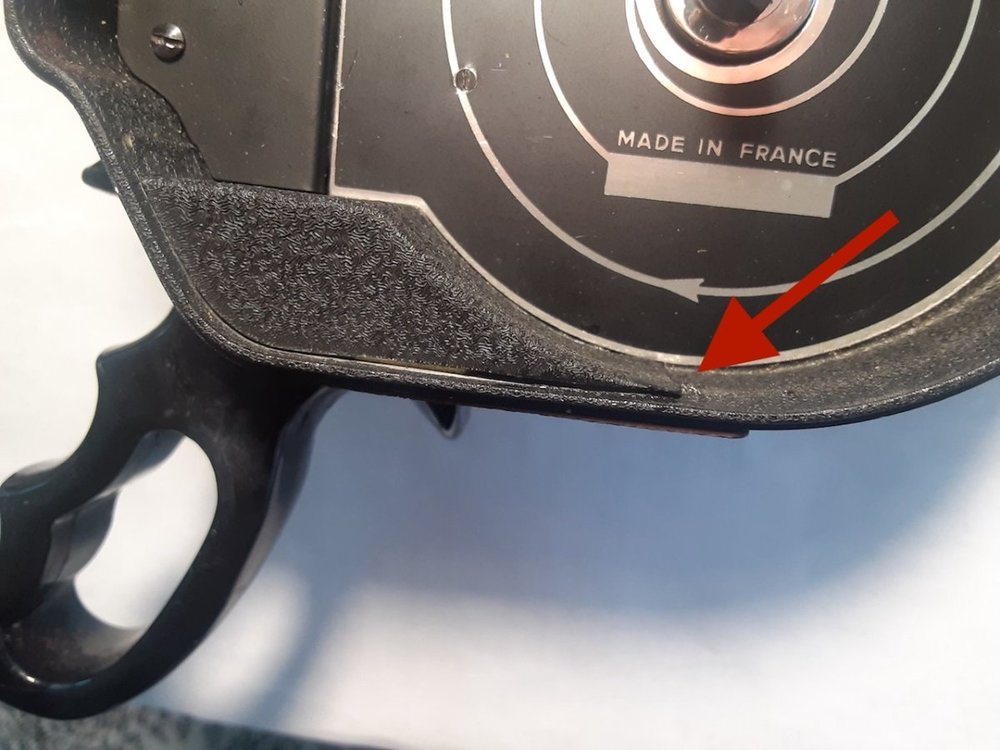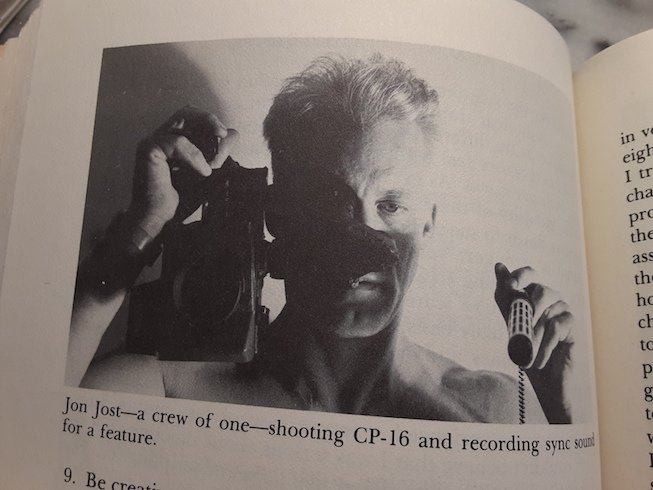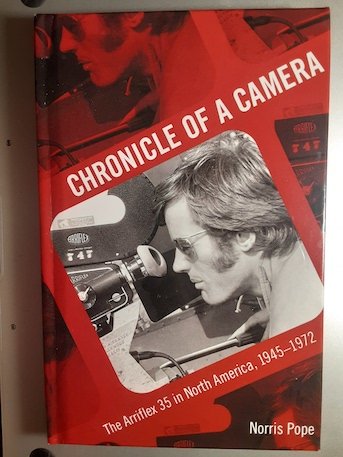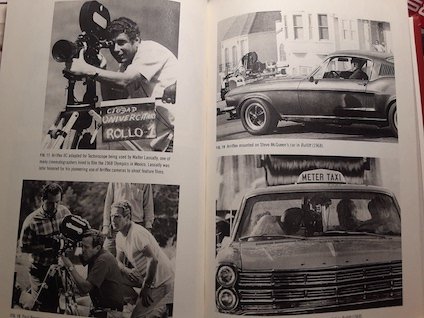
charles pappas
Basic Member-
Posts
167 -
Joined
-
Last visited
Everything posted by charles pappas
-
I am submitting this for any future "Google," searchers who are having their film pile up at the take-up reel of their Beaulieu R-16s. This bedeviled me for quite a while, and a Beaulieu tech missed it (or gave it the sunshine treatment). I finally noticed that lip of the metal cap (at the arrow) had pulled up from the housing, causing drag then pile up of the film. I used epoxy to stick the lip back down. As shown in the photo the front of the lip was and is still pulled up off the housing but the back half stuck down and that eliminated the drag.
- 1 reply
-
- 1
-

-
Let’s play with practicals
charles pappas replied to Nicolas POISSON's topic in Lighting for Film & Video
Random questions: What about composition? Does the lamp in the middle of the frame dominate the actors? The pen. Does it dominate the actors (as it appears to have its own mini-spotlight devoted to it)? -
NOTICE: THE FOLLOWING POST IS TRIVIAL, UN-CONSTRUCTIVE AND ONLY TANGENTIALLY RELATED TO THIS WEBSITE: I have never forgotten Tyler Purcell's post several years ago severely criticizing the software and menus on Sony professional video cameras. I have never used such cameras, but his post rang so true to me because of my experiences years earlier with a Walkman AM-FM earphone device and later with a Sony radio-CD-cassette tape combo (that I still use in my kitchen, as a testament to my thrift). As I finished reading that thread years ago I have to say that some self-doubt crept into me, and has persisted over the years. That was because some other posters in that thread maintained that the software and menus weren't really that bad, or bad at all, and by extension I wondered if my reaction to the Sony software on my devices - thinking it miserable - was fully, or perhaps even partially, justified. Now, years later, I pass on with a grin the very first comment to this morning's Ars Technica article on a new Sony OLED TV: So, more than double the price of an LG, and we have to deal with Sony software? That picture would have to be hella bright to justify $3000.
-
Rewinds, a splicer, and viewer like a Zeiss Moviescope or Craig viewer should do the trick.
-
Why in the world would Kodak want to divulge any information that could possibly affect the price of silver, even if they were, as I suspect they are, so well hedged with long term fixed -price contracts and call options that the spot price of silver is immaterial to them? Why potentially stress-out suppliers lower down the chain and why potentially open themselves up to lawsuits from speculators?
-
Hopefully Kodak is doing what I understand a consumer of silver should be doing which is either holding long options (calls) and/or having long term fixed-price contracts with silver sellers (who would in turn hold short options (puts)). However, they wouldn't be the first commodity consumer to be speculating on their commodity instead of hedging.
-
Cinematographer? Fake it till you make it.
charles pappas replied to Stephen Sanchez's topic in General Discussion
I would be worried, I think, about some deep-pocketed disruptor deciding to "uberize," low-budget production. -
Short and sweet! Excellent! One reason I watched it twice was because at 0.36 it looked like the hands were ensnared in a fine mesh netting, and that idea hooked me in for a least a few more seconds until the rest of the film resumed for me. That could be a scheme worth remembering: a judiciously used very subtle, and subtilely disorienting, shot that can be "explained away," but serves to hook the viewer.
-
Cinematographer? Fake it till you make it.
charles pappas replied to Stephen Sanchez's topic in General Discussion
Boogie Nights, or Gresham's Law. -
Victor Duncan Production Equipment Catalog
charles pappas replied to charles pappas's topic in General Discussion
Thanks you, I will be in Chicago sometime in August, and will contact you beforehand, if that's ok. -
Victor Duncan Production Equipment Catalog
charles pappas replied to charles pappas's topic in General Discussion
Thanks, I hadn't thought of an AFI or ASC donation, but that will probably now happen when the time is right. I went to Victor-Duncan once or twice just to gawk, as a side pilgrimage on infrequent trips to Dallas. I'm attaching his obituary that I just read: DUNCAN, ASC, VICTOR Son of Clark and Margaret Duncan, born October 5, 1924, passed away peacefully in his sleep at his home in Frisco, TX on September 18, 2007. While attending Highland Park High School in December 1941 as a junior, he joined the U.S. Navy and honorably served his country during WWII. After the war and earning his diploma, he attended SMU for two years and finished college at the USC Film School in California. Following his dream, he became a cameraman achieving ASC status with numerous Charles Guggenheim documentaries, including "The Monument to a Dream" as well as the dramatic film "The Great St. Louis Bank Robbery", starring Steve McQueen. Along with his wife, Lee A. Duncan, he built the largest motion picture equipment rental and sales company in the Midwest; Victor Duncan Inc., which he sold in the late 80's, and is now known as Panavision of Dallas. He also became well known in the Model A Restorers Club winning many State and National trophies with his restored vehicles. In later years, he shared his love of film making through teaching at both SMU and North Texas State University and taught many of his own Victor Duncan Film and Lighting Workshops which lead to numerous short student films, and a nine part series of documentaries on restoring Model A Fords. He spent his later years of retirement near his family in Frisco, Texas. A Memorial Service will be held on Saturday, September 22nd, at 3 PM at The Lakewood Theatre, 1825 Abrams Rd. Dallas, TX. In lieu of flowers, please find it in your heart to make a donation to The Alzheimer's Foundation, in the name of Lee A. Duncan. Always a true and consummate gentleman, a gracious host, and the life of every party, he was dearly loved by all who ever knew him, and will be dearly missed. -
Chronicle Of A Camera (Arri II book) review
charles pappas replied to charles pappas's topic in General Discussion
Not a word about Arri III, just a little bit of history of the early 35mm BLs. I add that the book has virtually none of the info abut the Arri II that one finds in the camera's operator's manual. -
Chronicle Of A Camera (Arri II book) review
charles pappas replied to charles pappas's topic in General Discussion
Satsuki, I double checked and you're right, they crazy raised the prices. I ordered the hardcover in August and it has almost tripled since then. If I were buying now I would probably drop them a line and see if they could do something about that increase. At any rate, it's fun to read and won't be regretted, I believe. -
Sir, I could not possibly agree with you more in that everything has a market value (and I'm no free-enterprise parrot) - I think that has been the thrust of my two posts above, noting an exception for, as Mr. Calderon said, purchases that have a component of "learning a bit more, just playing and having fun, etc.," in which case I posted that the purchaser should just go ahead and buy if his personal finances allow it. Subsequent posters seemed to say there was a difference in the valuation of equipment, or in the business-models, between a rental house and an owner-operator and I attempted to say I didn't think there should be. I also digressed a bit and say that I didn't think there should not be a viable business-to-business-rental model in the film business for items costing less than (and I guessed an somewhat arbitrary number) at least $25,000, and that if a somewhat viable, worthwhile business model exists in renting lower-cost professional film-making equipment to professionals, I could only attribute that to a great turn-over of raw beginning professional operators. (I also said there would a minor market in renting to pros whose equipment was broke, or lost, or were doing multi-camera set-ups.) You said that you make a great deal of money renting small-ticket items for big studio high budget films you are working on, which would contradict what I think, that there should not be such a market. But are you really renting the producers a $360 4x5 filter for 36 dollars a week, or are you renting them a box of 30 4 x 5 filters worth $10,000, for 1,000 dollars a week? Are the producers renting the $3,500 monitors, only, from you for $600 a week, or are those monitors attached to a $50,000 camera the producers rent from someone else? Regarding my digression I acknowledge in advance I'm wrong if you say so. Thanks for your reply. Also, I found it very interesting that you prefer not to rent large-ticket to productions you are involved in, but after reflection it makes perfect sense.
-
Gregory Irwin: I’ve owned my camera rental company for 31 years. My payoff model is for large ticket items, I want the piece of gear paid off within 2.5 jobs. These purchases are mostly $100,000 or more so the return takes a little longer. For smaller rentals, you can get a payoff in much less time. Mr. Irwin, would you not agree that the only viable business/payoff model for an equipment rental firm or rental/owner side of an owner/operator is in renting big-ticket items? I think this would true in any business-to-business rental model. Guesstimating for the film rental business, I'd bet between $25,000 and $50,000 per camera or grip/lighting package, and $100,000 per lens set. Renting lower cost items, I would think, is in the long run, not a viable business-to-business model in any industry (whether renting to a film operator or producer, AC technician or commercial roofer). Not to say that in the beginning stages of a technology shift in any industry some money can't be made renting the new equipment as contractors first learn about it and it is just starting to work its way into their workflow. I know little about the digital imaging workflow but I think truly professional digital cameras costing under $25,000 (and also substantially under that) are a relatively new thing, so there was that. But now those cameras have now been around long enough that I don't think there should be any market at all to rent those lower-priced but professional cameras (except to keep some around for renters whose own equipment is broke, or need multi-camera for a while). Not to denigrate the cameras, or any other lower-price equipment for that matter. I know that all sorts of contractors, including camera operators, just have $25k (to pick a number) worth of their own equipment but make fortunes per year. I just don't think there is or should be, a rental market for that equipment. This is not to say that the camera owner/operator should internally charge off his lower-priced equipment for any more or any less than the rental house charges or would charge if they rented that equipment. To put it another way, the only reason an owner/operator would own his lower-priced equipment instead of renting it would be "convenience," i.e. the costs associated with renting it (like time and travel) and the costs of "convenience," would also be the reason the equipment renter or owner/operator renter would not rent out lower-priced equipment. The fact that it has been said here there is a somewhat viable, worthwhile business model in renting lower-cost professional film-making equipment to professionals I can only attribute to a great turn-over of raw beginning professional operators, and perhaps a tiny bit to the tradition of rentals in the film industry (going back to when DP's only owned a light meter).
-
As Mr. Calderon's question is now framed as a discussion of business-models and investment returns, let me add this. The business model of a rental house and the business model of the rental portion of an owner/operator should be identical. In other words, the owner/operator must charge for a specific piece of equipment what a convenient and accessible rental house would charge for the same item. Any variations should either be trivial or balance out over a short period of time. If equipment rental should be $1000 per day and and operator is $1000 per day the owner/operator can word-play and say I'm charging 800 for equipment and 1200 for me, but any producer would ignore that statement, and if they don't it's meaningless anyway. As for a producer trying to "get the prices down compared to some low rental rate they can get from the massive rental houses (are there any small ones left)," that seems to that the owner/operator is overcharging for his equipment or, more likely, undercharging for his services, or even more likely, more word-play is involved. If a rental house consistently charges less than marginal costs to producers, it will go broke. If it overcharges a large segment of its market, the operators, it will also, soon, destroy its own business model and go broke, or stop doing it. For both the rental house and the owner/operator equipment is a fixed cost; the owner/operator can live in a studio apartment with a roommate in a run-down area, but he must pay his fixed cost, that is, charge fully for it. As an aside, yes, "payback period," is a rule-of-thumb, but it is the least-best of established valuation methods, especially in a business like equipment rental or the owner side of an owner/operator business where inventory (for rental) is basically the business as a percentage of assets. It ignores the very significant opportunity costs.
-
I'm surprised none of your classmates had any interest in the fresh stock especially at that price. Curious if that is a required course where you attend. Thinking the worst, I assume they think by eventually completing the class they can check off the "shot film," box but don't really want to shoot film. Still I think - if I'm doing the hiring, and I have no doubt I'm wrong - the starting on film is the "best," way to learn movie-making. If I'm a passenger in the jet, I want the pilot who learned to fly in a single-engine prop, not a 737 simulator.
-
Thanks for bringing back memories (and the many helpful hints). Some years between 1985 and 1988 I shot many miles of high school football games with a CP-16/A and dog-leg Ang. 12-120 all on good old VNF (Video News Film). I also had a few disasters, I think once I lost the first half of a game. Loved the camera though, and it was great to be paid to shoot film ($75 a pop). Most of the 16/A 's were raggedy, but I borrowed the best one for a 16 minute narrative film. Somewhere I had met a NASA soundman, Pete, who owned an Nagra 3 and wanted to do narrative work. He did the sound free of course and I edited on a four-gang sync and Zeiss MovieScope. An industrial music group had contributed the soundtrack. Then I went with Pete to the Johnson Space Center one night and he did the final mix-down. An earlier film I had done had an Electro-Print soundtrack, but that window had just closed, so I had to make a real optical track. The check-print or whatever they call it was the only print made. I did it at the late Southwest Film Labs in Dallas. When I was there, there were three 90 year old editors cutting a Fred Williamson movie negative. They had to dust off the Hazeltine and call up the color timer, a woman incidentally, and I think female Hazeltine operators were common. At the time though, this was still the best way to get a decent movie image made and projected. Thanks again.
-
ok
-
Oops, shouldn't trust my gut. I looked up his filmography now, and it seemed to me at the time that Zodiac, Ben Button, Social Network and Dragon should have grossed higher. Panic Room was before those and successful I think, not sure if film or digital. Worth no more that 2 cents.
-
My $0.02 worth too, I've always had the gut feeling that when Fincher switched to video at the time he did (I believe with Collateral) he severely damaged his grosses - they all seemed to underperform. Edit: didn't know he did Gone Girl and Dragon Tattoo. Gone Girl was big hit I think, maybe Dragon Tattoo also.
-
Anyone have a Cinema Products GSMO?
charles pappas replied to Soren James's topic in Cine Marketplace
-
I ordered and received this book several months ago and read it straightaway. The subtitle is "The Arriflex 35 in North America, 1942-1972," and it does cover that topic thoroughly. It is written by Norris Pope, an academic and self-professed owner and user of an Arri II and is available through the University of Mississippi Press for just under $20 delivered. The book is, as mentioned thorough, and is of course well-researched which leads to my only minor "criticism," that some paragraphs of the book read as a laundry list of films made partly or entirely with the camera of honor. More than offsetting that, however, the book contains many fascinating anecdotes about Arri II-made films and those who made them in the timeframe covered, none of which I had come across. My impression is that in researching the book, the author, heard numerous anecdotes about low-budget and exploitation filmmakers and could have written 300 pages instead of 120 pages of narrative, 20 pages of photos and about 40 pages of Appendix and Notes (all well-worth reading) but chose to stay on point, as perhaps befits an academic. Needless to say, the book offers much consideration of this small reflex camera's many influences on the post-war movie-making process, including cinema-verite and documentary filmmaking. One example: the Arri II's role in increasing the accessibility of depth of field manipulation by lower budget productions. I should mention that the book also discusses the Arri II's role in European filmmaking as well as the Camflex's similar role. If niche history of the film industry holds any appeal to you, and you appreciate "hands-on," commemorations of cinematography (sans lighting), I would recommend purchasing this book (assuming a $20 bill is not a onerous burden).
-
One of the Koyanaquastsi (sp?) people, maybe the Monk himself, made a black and white shot-on-video film that I saw during the theatrical release. I can't remember the name of it, but it was in the vein of the others. It was shot in super-high def (at least for the time) video, and was made after Samsara, I think. The b/w video looked excellent as I recall, to my slight disappointment. The movie was, of course, also a tremendous movie. Now that I think about it, I saw Samsara in digital, and was not disappointed. On the topic, broadly, if I think of film (meaning film and video) only as film qua film, I have to say that Koyanaquastsi could be the best feature-length movie ever made.








